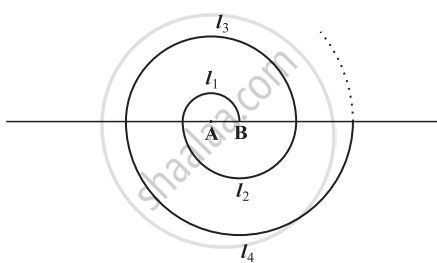Advertisements
Advertisements
Question
The 4th term of an AP is zero. Prove that its 25th term is triple its 11th term.
Solution
In the given AP, let the first be a and the common difference be d.
Then, tn = a + (n-1)d
Now , T4 = a + (4-1) d
⇒ a +3d = 0 ....................(1)
⇒ a = -3d
Again T11 = a + (11-1) d = a + 10 d
= -3d + 10d = 7d [ Using (1)]
Also , T25 = a + ( 25-1) d = a + 24d = - 3d + 24 d = 21d [Using (1)]
i.e . , T25 = 3 × 7d = ( 3 × T 11)
Hence, 25th term is triple its 11th term.
APPEARS IN
RELATED QUESTIONS
A spiral is made up of successive semicircles, with centres alternately at A and B, starting with centre at A of radii 0.5, 1.0 cm, 1.5 cm, 2.0 cm, .... as shown in figure. What is the total length of such a spiral made up of thirteen consecutive semicircles? (Take `pi = 22/7`)

[Hint: Length of successive semicircles is l1, l2, l3, l4, ... with centres at A, B, A, B, ... respectively.]
Which term of the AP 3,8, 13,18,…. Will be 55 more than its 20th term?
The 8th term of an AP is zero. Prove that its 38th term is triple its 18th term.
If the numbers a, 9, b, 25 from an AP, find a and b.
There are 37 terms in an A.P., the sum of three terms placed exactly at the middle is 225 and the sum of last three terms is 429. Write the A.P.
If the sum of a certain number of terms starting from first term of an A.P. is 25, 22, 19, ..., is 116. Find the last term.
In a Arithmetic Progression (A.P.) the fourth and sixth terms are 8 and 14 respectively. Find that:
(i) first term
(ii) common difference
(iii) sum of the first 20 terms.
If ₹ 3900 will have to be repaid in 12 monthly instalments such that each instalment being more than the preceding one by ₹ 10, then find the amount of the first and last instalment
Kanika was given her pocket money on Jan 1st, 2008. She puts Rs 1 on Day 1, Rs 2 on Day 2, Rs 3 on Day 3, and continued doing so till the end of the month, from this money into her piggy bank. She also spent Rs 204 of her pocket money, and found that at the end of the month she still had Rs 100 with her. How much was her pocket money for the month?
Find the sum of first 'n' even natural numbers.
